Table of Contents
Introduction to the Banana Bread Recipe
Banana bread is a beloved treat that combines the sweetness of ripe bananas with a soft, moist texture. Whether you’re a beginner baker or a seasoned pro, making banana bread is both easy and rewarding. It’s the perfect way to use overripe bananas, transforming them into something delightful. In this guide, we’ll cover everything from ingredients to baking tips, ensuring you make the best banana bread every time.
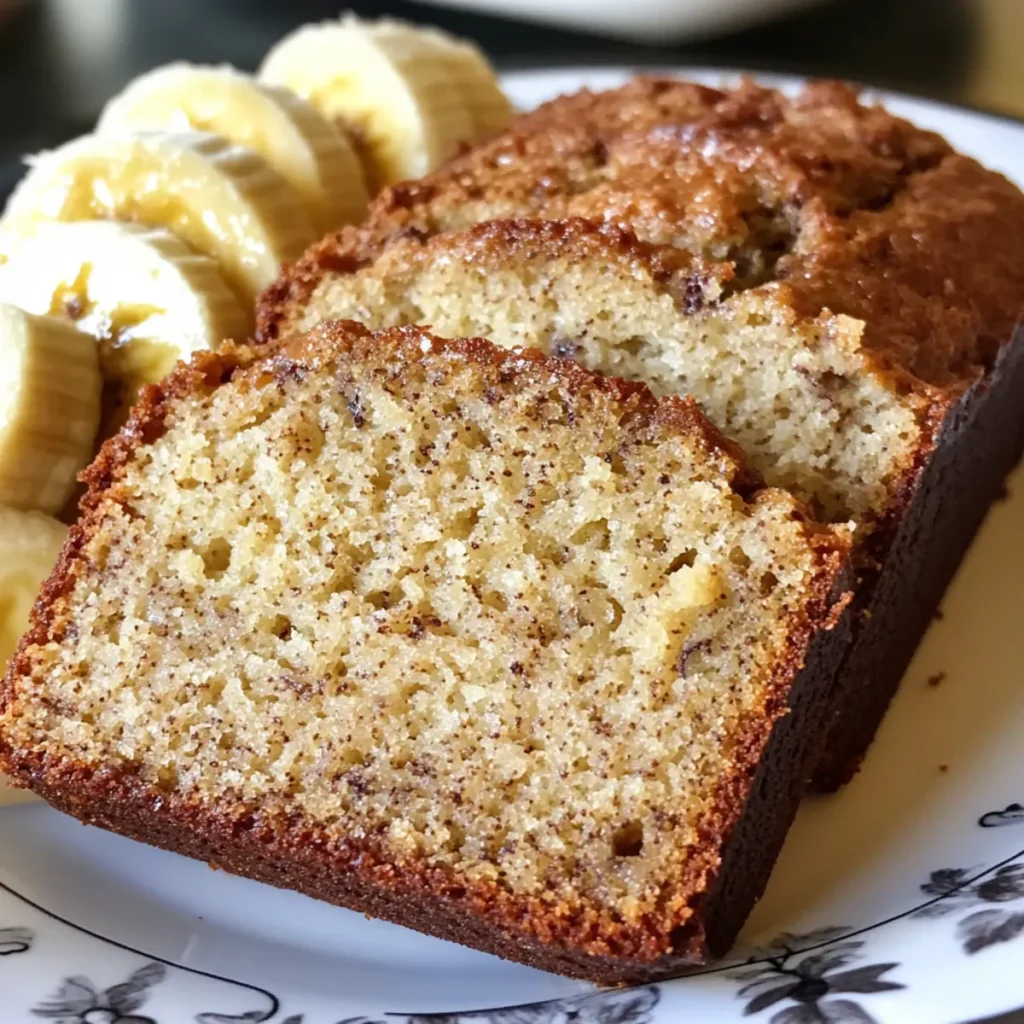
Part 1: How to Make the Perfect Banana Bread Recipe
Banana bread is a classic, beloved treat that’s easy to make and always a crowd-pleaser. Whether you’re an experienced baker or trying your hand at it for the first time, this recipe will guide you through the process of creating the most delicious banana bread. With simple ingredients and easy steps, you’ll enjoy a soft, moist loaf with a hint of sweetness and the perfect texture. Let’s dive into the details of how to make this banana bread recipe from scratch.
Essential Ingredients for Banana Bread recipe
Before you can start baking, gather all the necessary ingredients for your banana bread. The beauty of this banana bread recipe lies in its simplicity. It requires only a handful of common ingredients that you probably already have at home. Here’s the list you’ll need:
Banana Bread Ingredients
- 3 ripe bananas (mashed)
- 1 cup all-purpose flour
- 1/2 cup unsalted butter (softened)
- 1/2 cup granulated sugar
- 2 large eggs
- 1 teaspoon baking soda
- 1/2 teaspoon salt
- 1 teaspoon vanilla extract
With these simple ingredients, you’re all set to make banana bread that’s full of flavor and incredibly moist.
Step-by-Step Instructions for the Banana Bread Recipe
Now that you have everything ready, follow these easy steps to make the perfect banana bread.
1. Preheat the Oven and Prepare the Pan
Start by preheating your oven to 350°F (175°C). This will ensure that your banana bread bakes evenly. While the oven is heating up, grease a 9×5-inch loaf pan with butter or non-stick spray. Alternatively, you can line it with parchment paper to make removing the bread easier once it’s done.
2. Mash the Bananas
In a medium-sized bowl, peel your ripe bananas and mash them with a fork until they’re smooth. You can leave some chunks if you prefer a bit of texture in your bread. The riper the bananas, the sweeter your bread will be, so don’t be afraid to use those overripe bananas!
3. Mix Wet Ingredients
In a separate bowl, cream together the softened butter and sugar until the mixture is light and fluffy. This will give your banana bread a soft texture. Add the eggs, one at a time, mixing well after each addition. Finally, stir in the mashed bananas and vanilla extract.
4. Combine Dry Ingredients
In another bowl, whisk together the flour, baking soda, and salt. Ensure there are no lumps. Once the dry ingredients are well combined, gradually add them to the wet ingredients, mixing gently until just incorporated. Be careful not to overmix, as this can lead to a denser loaf.
5. Pour the Batter into the Pan
Once your batter is ready, pour it into the prepared loaf pan. Use a spatula to smooth the top and spread the batter evenly.
6. Bake the Banana Bread
Place the pan in the preheated oven and bake for 60 to 65 minutes or until a toothpick inserted into the center comes out clean. The top should be golden brown, and the bread will have a slight crack down the middle. If the top is browning too quickly, cover it with aluminum foil and continue baking.
7. Cool and Serve
After baking, remove the loaf from the oven and allow it to cool in the pan for about 10 minutes. Then, transfer it to a wire rack to cool completely. Once cooled, slice it up and enjoy your freshly baked banana bread!
Part 2: Banana Bread recipe Variations and Customization Tips
Banana bread is already a delicious treat on its own, but did you know you can easily customize it to suit different tastes? Whether you prefer adding a bit of texture, extra flavor, or even making it healthier, the options are endless. Let’s explore some tasty variations and substitutions you can try out.
a- Customizing Your Banana Bread Recipe
1. Add Chocolate Chips for Extra Indulgence
If you’re a fan of chocolate, adding some chocolate chips to your banana bread is a fantastic idea. Not only does it make the bread richer and sweeter, but it also gives you the perfect balance of chocolate and banana flavors. Simply fold in 1/2 cup of chocolate chips (milk or dark chocolate, depending on your preference) into the batter before pouring it into the loaf pan.
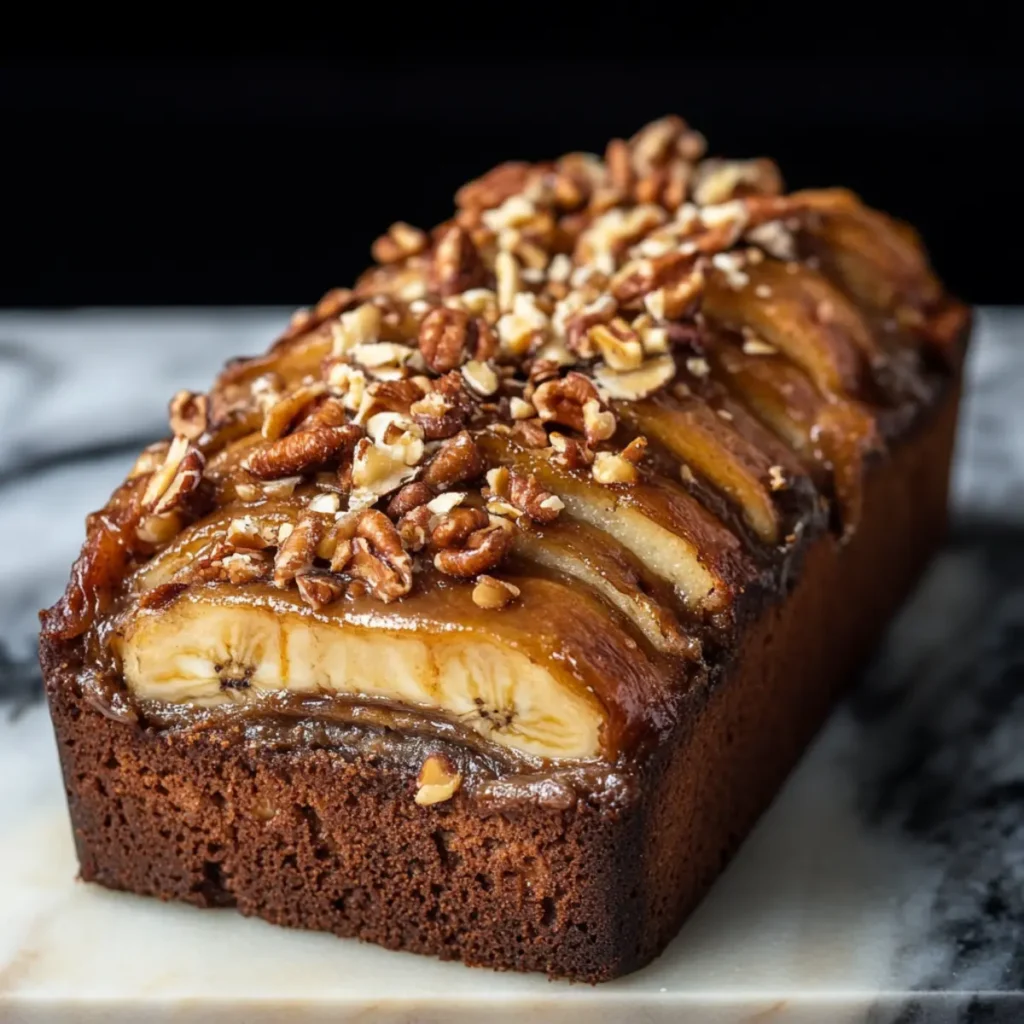
2. Add Nuts for a Crunchy Texture
Nuts, such as walnuts or pecans, add an irresistible crunch to your banana bread. They’re also a great source of healthy fats. You can add 1/2 cup of chopped nuts to the batter for a delightful texture contrast. If you love a little extra flavor, try toasting the nuts in a dry skillet for a minute or two before adding them to the mix. This will enhance their flavor and make your banana bread even more delicious.
3. Make It Healthier with Whole Wheat Flour
If you’re looking for a healthier twist on the classic banana bread recipe, you can substitute whole wheat flour for regular all-purpose flour. Whole wheat flour adds more fiber to the bread, which is great for digestion. You may want to use half whole wheat flour and half all-purpose flour to keep the texture soft while adding some extra nutrients.
4. Swap Sugar for Natural Sweeteners
To reduce the amount of refined sugar in your banana bread, try using natural sweeteners like honey or maple syrup. Replace the 1/2 cup of sugar with 1/3 cup of honey or 1/4 cup of maple syrup. Keep in mind that these liquid sweeteners will affect the batter’s consistency, so you may need to reduce the amount of liquid ingredients slightly. You can also use coconut sugar for a more natural, unrefined alternative.
5. Vegan Banana Bread Recipe
For a vegan version of banana bread, simply substitute the eggs and butter with plant-based alternatives. Use flax eggs (1 tablespoon of ground flaxseed mixed with 3 tablespoons of water for each egg) and substitute vegan butter or coconut oil for the butter. You can also try using unsweetened applesauce as a replacement for eggs to keep the bread moist.
b- Troubleshooting Common Banana Bread Problems
Even with the best recipe, things might not always go as planned. Here are a few tips to help you troubleshoot any common banana bread problems and ensure that your loaf turns out perfect every time.
1. Banana Bread is Too Dense
If your banana bread turns out too dense, it’s likely that the batter was overmixed. When you combine the dry and wet ingredients, mix gently and only until just incorporated. Overmixing develops the gluten in the flour, leading to a heavier texture.
2. Banana Bread is Too Dry
If your banana bread ends up dry, it could be due to overbaking or using too much flour. Make sure to check for doneness with a toothpick; it should come out clean but not overly dry. If you’re using whole wheat flour, it can sometimes dry out the bread, so consider adding an extra mashed banana or a little more liquid next time.
3. The Top of the Banana Bread Cracks
A cracked top is usually a sign of the bread rising too quickly. To prevent this, make sure the oven temperature is set correctly and that your bread is baking evenly. If the top cracks too early, cover it with aluminum foil to slow down the rise.
4. Banana Bread Doesn’t Rise Enough
If your banana bread doesn’t rise as much as expected, it could be due to expired baking soda or not enough leavening. Always check the freshness of your baking soda before using it. Also, be sure to follow the recipe’s measurements for accurate results.
c- Healthy Banana Bread Recipe Substitutions
For those looking to make their banana bread healthier, there are several easy substitutions you can make to cut down on sugar, fats, and calories without compromising taste.
1. Substitute Greek Yogurt for Butter
If you want to reduce the fat content in your banana bread, you can replace the butter with Greek yogurt. This will still keep the bread moist while cutting down on the fat. Use 1/2 cup of Greek yogurt for every 1/2 cup of butter. Additionally, it adds a slight tangy flavor that complements the sweetness of the bananas.
2. Use Almond Flour for a Gluten-Free Option
For those following a gluten-free diet, you can replace regular flour with almond flour. This substitution will give your banana bread a slightly nutty flavor and a denser texture. Use 1:1 ratio when substituting almond flour for all-purpose flour.
3. Reduce Sugar with Stevia
For a low-calorie, low-sugar version of banana bread, you can replace the sugar with Stevia or monk fruit sweetener. These natural sugar substitutes provide the sweetness you love without adding extra calories or sugar. Start with 1/4 teaspoon of Stevia for every 1/4 cup of sugar and adjust to taste.
Part 3: Baking Tips and Creative Ways to Serve Banana Bread recipe
Banana bread is incredibly versatile, and with a few baking tips and creative ideas for serving, you can elevate this simple recipe even further. Whether you want to serve it as a quick breakfast or pair it with a cup of coffee for a cozy snack, there are endless possibilities for how to enjoy this treat. Let’s take a closer look at some expert baking tips and fun ways to serve your banana bread.
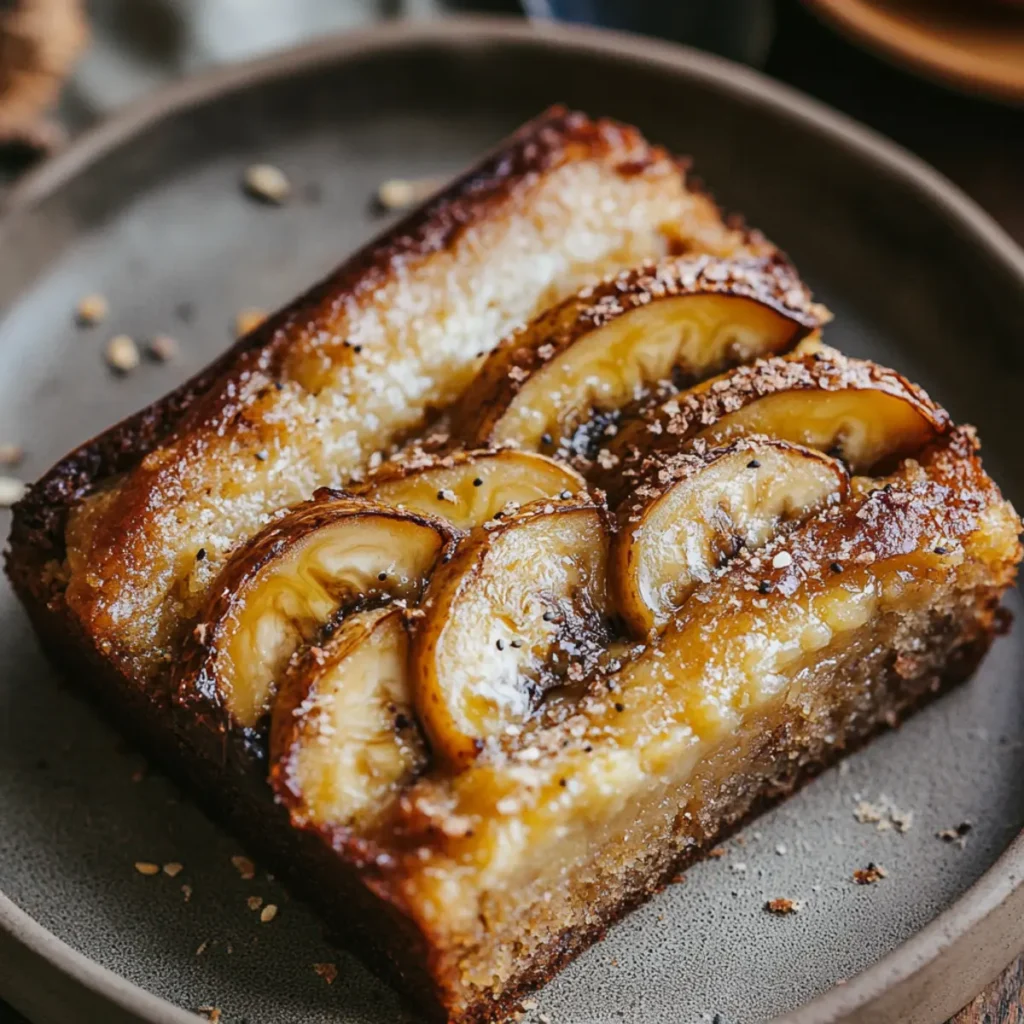
Essential Baking Tips for Perfect Banana Bread
To make sure your banana bread turns out perfectly every time, follow these handy baking tips:
1. Use Ripe Bananas for Maximum Flavor
The key to delicious banana bread is using ripe bananas. The more ripe your bananas are, the sweeter and more flavorful the bread will be. Overripe bananas, which have brown spots on the peel, are the best choice because they’re naturally sweeter and easier to mash.
2. Don’t Overmix the Batter
When mixing the wet and dry ingredients, be sure to mix gently and just until everything is combined. Overmixing can lead to tough, dense banana bread due to the overdevelopment of gluten. To avoid this, use a spatula or wooden spoon and stop mixing as soon as the flour is incorporated.
3. Check for Doneness Early
Ovens vary in temperature, so it’s a good idea to start checking for doneness about 5 minutes before the recommended baking time is up. Insert a toothpick into the center of the loaf—if it comes out clean or with just a few crumbs attached, the bread is done. If it’s still wet, continue baking and check every few minutes until it’s fully baked.
4. Let the Bread Cool Before Slicing
It’s tempting to slice into your banana bread as soon as it comes out of the oven, but it’s best to let it cool for at least 10 minutes in the pan. This allows the bread to firm up and makes it easier to slice without it falling apart. After 10 minutes, transfer it to a wire rack to cool completely before slicing.
Creative Ways to Serve Banana Bread
While banana bread is perfect on its own, there are many ways to get creative with serving. Here are a few ideas to inspire you:
1. Banana Bread with Nut Butter
For a protein-packed snack, spread some peanut butter, almond butter, or hazelnut spread on a slice of banana bread. The creamy, nutty flavors pair wonderfully with the soft, sweet banana bread. It’s an ideal breakfast or afternoon snack!
2. Serve with Fresh Fruit and Yogurt
Another delicious serving idea is to top a slice of banana bread with fresh fruit like berries, bananas, or kiwi, along with a dollop of Greek yogurt. This adds a refreshing contrast to the sweetness of the bread and makes for a wholesome breakfast or snack.
3. Banana Bread French Toast
For a fun twist, turn your banana bread into French toast! Dip slices of banana bread into an egg mixture, then cook them in a skillet until golden brown on both sides. Serve with a drizzle of maple syrup, powdered sugar, and fresh berries for a decadent brunch treat.
4. Make Mini Banana Bread Loaves for Gift Giving
Banana bread makes a wonderful homemade gift. Pour the batter into smaller loaf pans, bake, and allow them to cool completely. Wrap them in parchment paper or a cute gift box and share with friends, family, or colleagues. It’s a thoughtful and tasty gift that’s sure to be appreciated!
5. Banana Bread with Ice Cream
For a more indulgent dessert, serve banana bread with a scoop of vanilla ice cream or your favorite frozen treat. The warm, soft bread paired with cold, creamy ice cream is an irresistible combination.
Storage and Freezing Tips for Banana Bread
If you have leftover banana bread (which is rare!), there are a few ways to store it to maintain its freshness.
1. Storing Banana Bread at Room Temperature
Banana bread stays fresh for about 3-4 days when stored at room temperature. Simply wrap the loaf tightly in plastic wrap or store it in an airtight container to prevent it from drying out.
2. Freezing Banana Bread
If you want to store banana bread for a longer period, freezing it is a great option. To freeze banana bread, slice it first, then wrap each slice in plastic wrap and place the slices in a freezer bag or airtight container. When you’re ready to enjoy, simply thaw a slice at room temperature or heat it up in the microwave for a quick treat.
Serving Suggestions Summary
Banana bread is versatile, and with these tips, you can enjoy it in many different ways. From making it healthier with substitutions to creating indulgent versions like French toast or pairing it with nut butter, the possibilities are endless. And with a little creativity, you can make banana bread a star at any meal or event.
Part 4: The Benefits of Banana Bread recipe and Using Bananas as an Ingredient
Banana bread isn’t just a delicious treat; it also has some surprising health benefits, thanks to the star ingredient: bananas. Bananas are packed with essential nutrients, including potassium, vitamins, and fiber. When you incorporate them into a recipe like banana bread, you’re not only enjoying a tasty snack but also gaining some nutritional value. In this section, we’ll explore the benefits of banana bread and why bananas are such a great addition to your diet.
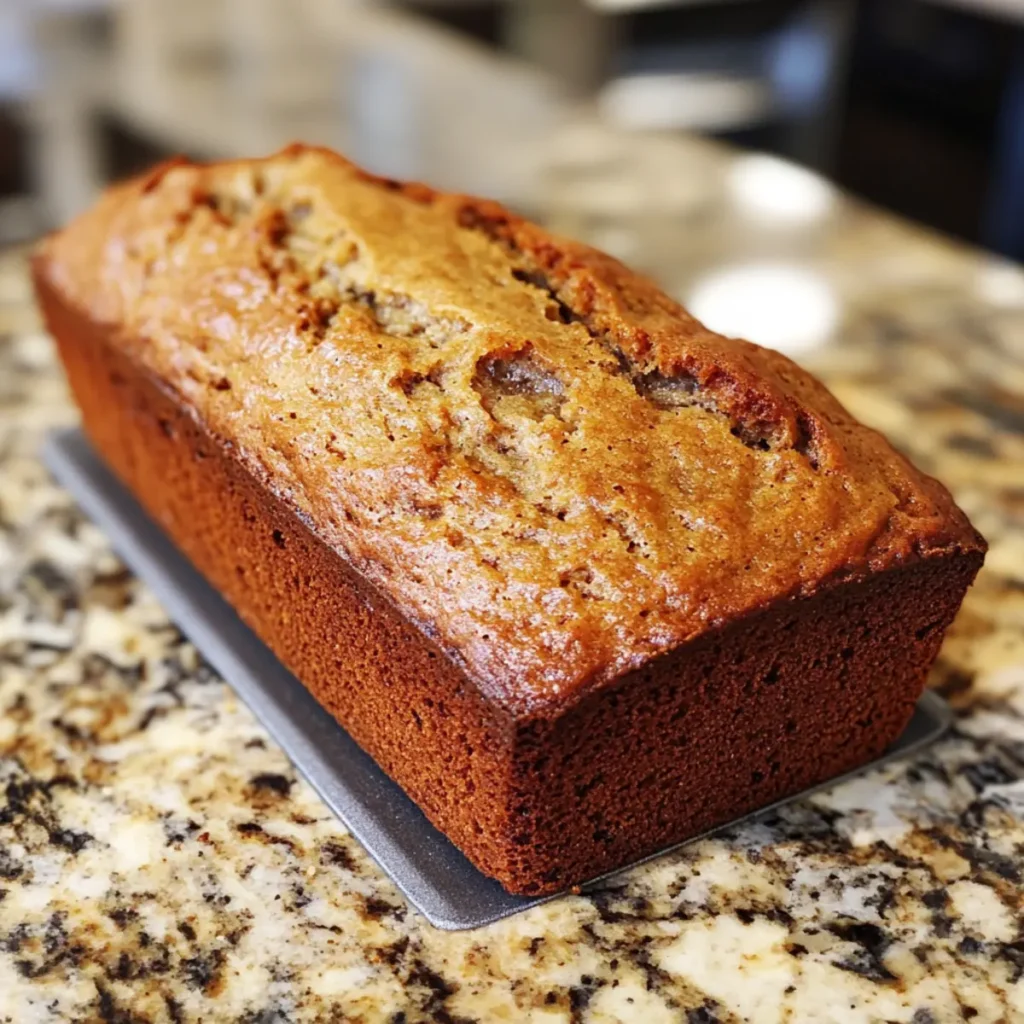
Nutritional Benefits of Bananas
Bananas are often called a superfood, and for good reason. Here’s why bananas are an excellent ingredient to use in your banana bread recipe:
1. Rich in Potassium
Bananas are well-known for their high potassium content. Potassium is a vital mineral that helps regulate blood pressure, support heart health, and maintain muscle and nerve function. Including bananas in your banana bread helps boost your potassium intake in a tasty, enjoyable way.
2. Packed with Vitamins
Bananas are a good source of several essential vitamins, including Vitamin C, Vitamin B6, and Vitamin A. Vitamin C is crucial for immune function, while Vitamin B6 supports brain health and helps produce red blood cells. By using bananas in your banana bread, you get a natural boost of these important vitamins.
3. A Great Source of Fiber
Bananas are high in dietary fiber, especially when you use overripe bananas for your bread. Fiber is essential for digestive health, as it helps regulate bowel movements and prevent constipation. Additionally, a high-fiber diet can contribute to weight management and lower the risk of chronic diseases, such as heart disease and type 2 diabetes.
4. Natural Sweetness
One of the best things about using bananas in your banana bread is that they provide natural sweetness without the need for added sugar. Overripe bananas are packed with natural sugars, which make your bread deliciously sweet while keeping it healthier. This allows you to reduce the amount of added sugar in the recipe, making it a better option for those looking to cut down on refined sugars.
5. Mood-Boosting Benefits
Bananas contain tryptophan, an amino acid that the body uses to produce serotonin—the “feel-good” neurotransmitter. Serotonin plays a role in regulating mood and promoting a sense of well-being. Enjoying a slice of banana bread made with ripe bananas may just help improve your mood, making it a perfect treat to enjoy on a cozy day.
Bananas as an Ingredient in Other Recipes
While banana bread is a classic way to enjoy bananas, there are many other delicious recipes that use bananas as a key ingredient. Bananas are versatile and can be incorporated into both sweet and savory dishes. Here are some ideas for using bananas beyond banana bread:
1. Smoothies
Bananas are a perfect addition to smoothies. Their natural sweetness and creamy texture make them a great base for many smoothie recipes. Combine banana with other fruits like berries, mango, or spinach for a nutritious, filling drink. You can even freeze bananas to create a thicker, ice-cream-like texture in your smoothies.
2. Banana Pancakes
Bananas can be used to make fluffy banana pancakes. Simply mash a ripe banana and add it to your pancake batter for extra flavor and sweetness. These pancakes are a great way to enjoy bananas for breakfast, and they pair wonderfully with a drizzle of maple syrup and a sprinkle of cinnamon.
3. Banana Oatmeal
For a healthy breakfast, slice bananas into your oatmeal. The natural sweetness from the banana reduces the need for added sugar, and the fruit adds extra fiber and nutrients to your meal. Bananas are especially tasty when paired with rolled oats, nuts, and a drizzle of honey.
4. Banana Muffins
If you love banana bread, banana muffins are another great option. These individual servings are perfect for breakfast or a snack on the go. Add some chocolate chips, nuts, or dried fruit to the batter for an extra burst of flavor.
5. Frozen Banana Treats
Frozen bananas make an excellent base for a cool, refreshing treat. Slice a banana into small pieces, freeze the slices, and enjoy them as a sweet, healthy snack. You can also dip the frozen banana slices in dark chocolate and freeze them again for an indulgent, guilt-free dessert.
How Banana Bread Fits into a Balanced Diet
While banana bread can be a healthy treat when made with wholesome ingredients, it’s important to enjoy it as part of a balanced diet. Here’s how banana bread can fit into your daily meals:
1. A Wholesome Breakfast Option
Pair a slice of banana bread with a source of protein, such as Greek yogurt or scrambled eggs, for a filling and balanced breakfast. The combination of protein, healthy fats, and carbohydrates from the bread will keep you energized throughout the morning.
2. A Satisfying Snack
Banana bread makes a great snack when you need something quick and satisfying. It provides a boost of natural energy from the bananas and a bit of sweetness to curb your sugar cravings. For a balanced snack, pair a slice of banana bread with a handful of nuts or a piece of fruit.
3. An Afternoon Pick-Me-Up
Instead of reaching for a sugary treat, enjoy a slice of banana bread with a cup of tea or coffee. The complex carbs from the bananas and flour help stabilize blood sugar levels, giving you a more sustained source of energy than a candy bar or pastry.
4. Perfect for Post-Workout
The natural sugars in bananas can help replenish glycogen stores after a workout, making banana bread a good post-exercise snack. The combination of carbohydrates and protein will help repair muscles and keep your body fueled.
Conclusion: Why Banana Bread is a Nutritious and Tasty Treat
Banana bread is not just a delicious indulgence; it’s also packed with the goodness of bananas. From their high potassium content to their natural sweetness, bananas provide numerous health benefits. Whether you’re making banana bread as a snack, breakfast, or dessert, it’s a great way to incorporate nutritious bananas into your diet.
By following healthy substitutions, such as using whole wheat flour, reducing sugar, and adding in nuts, you can make banana bread even more nutritious without sacrificing taste. It’s the perfect combination of flavor, texture, and nutritional value, making it a treat everyone can enjoy guilt-free.
Part 5: Frequently Asked Questions (FAQ) About Banana Bread recipe
Banana bread is a popular recipe, and as with any beloved dish, there are plenty of questions that arise when making it. In this section, we’ll answer some of the most frequently asked questions (FAQs) related to banana bread, covering everything from storage to ingredient swaps. This should help clear up any confusion and ensure you make the best banana bread possible every time.
1. How Do I Know When Banana Bread is Done Baking?
One of the most common questions when making banana bread is how to tell if it’s fully baked. Here’s a simple method to check for doneness:
- Insert a toothpick or cake tester into the center of the loaf. If it comes out clean or with just a few moist crumbs, the banana bread is done.
- If the toothpick comes out with wet batter, it needs a little more time. Keep checking every 5 minutes or so until the toothpick comes out clean.
- Additionally, the top of the loaf should be golden brown, and the bread should have a slightly firm texture when you press gently on it.
2. Can I Freeze Banana Bread?
Yes! Freezing banana bread is an excellent way to preserve it for later. Here’s how you can do it:
- Whole loaf: Allow the banana bread to cool completely, then wrap it tightly in plastic wrap or aluminum foil. Place it in a freezer-safe bag or container. This will keep the bread fresh for up to 3 months.
- Slices: If you prefer individual servings, slice the bread before freezing. Wrap each slice tightly and place them in a freezer bag. This way, you can easily take out a slice whenever you want it.
To thaw, simply leave the bread at room temperature for a few hours or microwave individual slices for 15-20 seconds.
3. Can I Use Frozen Bananas to Make Banana Bread?
Absolutely! In fact, frozen bananas work wonderfully in banana bread. Freezing bananas actually brings out their sweetness, making them even more flavorful for baking. Here’s how to use them:
- Thawing: Simply let the frozen bananas thaw at room temperature or microwave them for a few seconds to soften them. Once thawed, peel them and mash them as you normally would.
- Baking: You can use them just like fresh bananas in the recipe. Keep in mind that frozen bananas may release more moisture than fresh bananas, so you might need to reduce the amount of liquid in your recipe slightly.
Frozen bananas are perfect for when you have ripe bananas on hand that you don’t want to waste.
4. Can I Use Other Types of Flour in Banana Bread?
Yes, you can experiment with different types of flour in your banana bread, depending on dietary needs or preferences. Here are a few options:
- Whole wheat flour: This is a great choice for a healthier banana bread. It adds fiber and a slightly nutty flavor to the bread. You can substitute half whole wheat flour and half all-purpose flour for the best results.
- Gluten-free flour: If you’re looking for a gluten-free version, try using a gluten-free flour blend. Make sure to add a binding agent like xanthan gum or guar gum to ensure the bread holds together.
- Almond flour: For a low-carb or keto-friendly banana bread, almond flour is a great option. It will give your bread a denser texture but still offer a rich flavor.
Make sure to adjust other ingredients slightly when using alternative flours, as they can behave differently than regular flour.
5. How Can I Make My Banana Bread More Moist?
If your banana bread turns out too dry, here are a few tips to help you achieve a moist loaf:
- Use overripe bananas: The riper the bananas, the more moisture they provide. Make sure your bananas have plenty of brown spots on the peel before using them.
- Add yogurt or sour cream: Adding 1/4 cup of Greek yogurt or sour cream to the batter can help keep the bread moist and tender.
- Check the baking time: Overbaking your banana bread can lead to a dry loaf. Be sure to check it for doneness a little earlier than the recipe states to avoid overbaking.
6. Can I Make Banana Bread Without Eggs?
Yes, you can make eggless banana bread! Here are some egg substitutes you can use:
- Flax eggs: Mix 1 tablespoon of ground flaxseed with 3 tablespoons of water and let it sit for 5-10 minutes to form a gel-like consistency. This mixture works as a binding agent and will help give the bread structure.
- Applesauce: For a moisture-rich substitute, use 1/4 cup of unsweetened applesauce for each egg in the recipe.
- Banana: You can also replace each egg with 1/4 cup of mashed banana for an extra banana flavor in your bread.
Any of these substitutes will help create a moist, eggless version of banana bread.
7. How Can I Make Banana Bread Sweeter Without Adding Sugar?
If you want to avoid refined sugar while still achieving a sweet banana bread, consider these alternatives:
- Ripe bananas: Overripe bananas are naturally very sweet. By using more ripe bananas, you can reduce the amount of added sugar or sweeteners.
- Honey or maple syrup: For a natural sweetness, substitute refined sugar with honey or maple syrup. Use 1/4 cup of honey or 1/3 cup of maple syrup for each cup of sugar.
- Stevia or monk fruit sweetener: These low-calorie, sugar-free sweeteners can help you reduce sugar while still achieving the desired sweetness. Use them in small amounts, adjusting to taste.
These natural sweeteners provide a healthier alternative while keeping your banana bread delicious.
8. Can I Add Other Fruits to My Banana Bread?
Yes! Adding other fruits to banana bread can create exciting new flavors and textures. Some great options include:
- Berries: Blueberries, raspberries, or strawberries can be mixed into the batter for a fruity twist.
- Apples: Small pieces of apple can be folded into the batter for added moisture and a touch of sweetness.
- Pineapple: Chopped pineapple adds tropical flavor to your banana bread. Make sure to drain excess moisture if using canned pineapple.
Feel free to get creative and add your favorite fruits for a deliciously unique banana bread!
Conclusion: Banana Bread Made Easy
Banana bread is a versatile and delicious treat that can be enjoyed in countless ways. With the right tips and ingredient swaps, you can make a loaf that suits your personal preferences and dietary needs. Whether you’re looking to create a healthier version, trying to avoid certain ingredients, or simply experimenting with different flavors, banana bread is adaptable and forgiving.
We hope this FAQ section helped clear up any questions you might have had and provided you with extra inspiration for your next loaf. Happy baking!

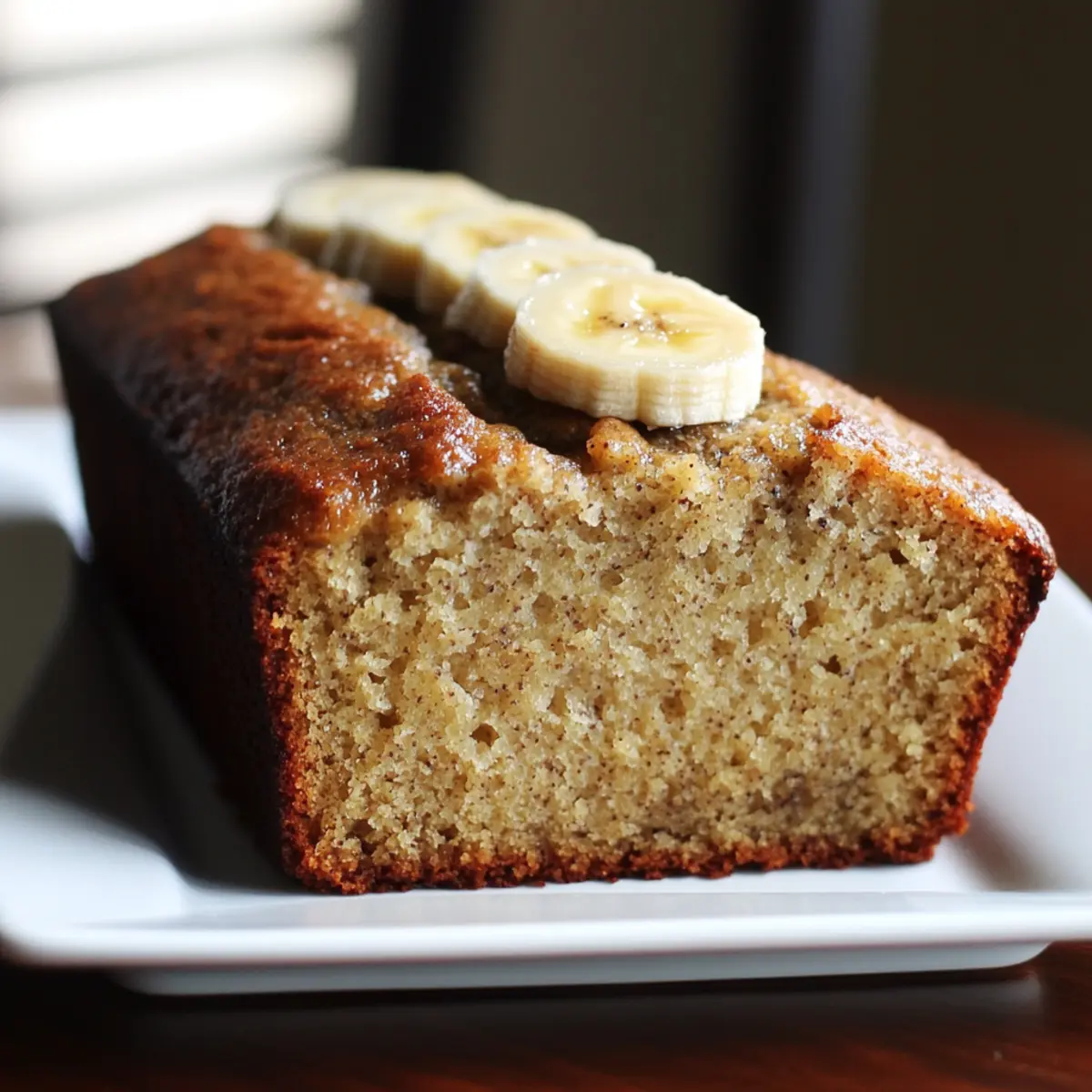
3 thoughts on “Banana Bread Recipe – A Step-by-Step”